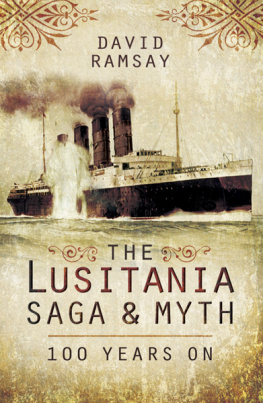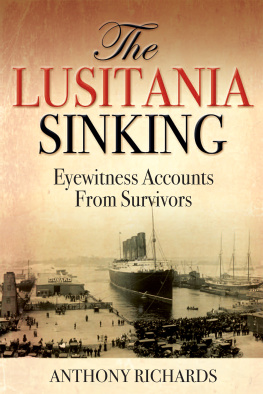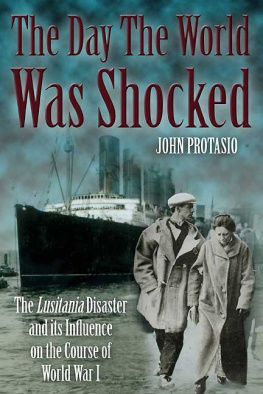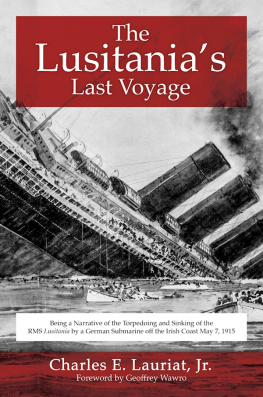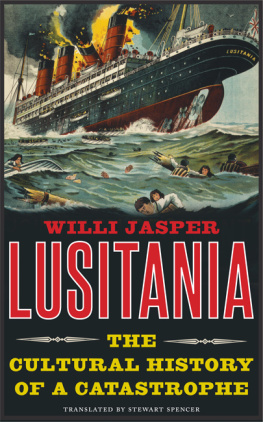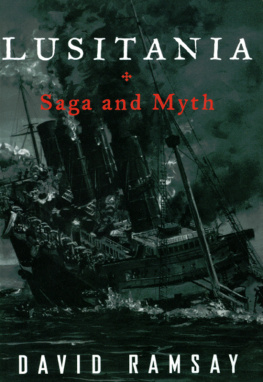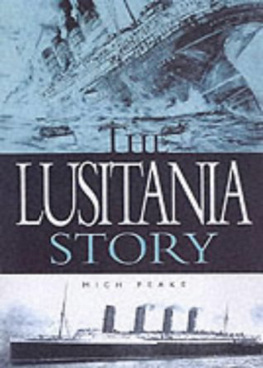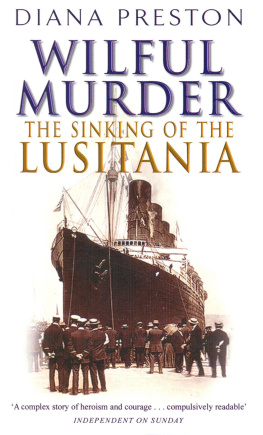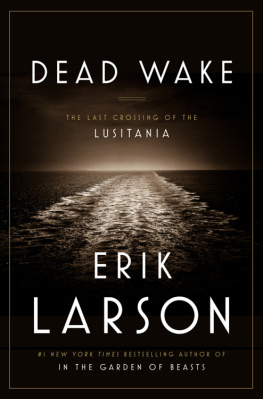DEDICATION
This book is dedicated to the memory
of all those who sailed from New York
on the 101st Eastbound Voyage of RMS Lusitania
on May The First 1915
and especially to Alice Lines Drury
Centenarian and Lusitania Survivor
December 1896 November 1997
who in those terrible minutes of adversity
on the afternoon of May the Seventh
by virtue of her courage and tenacity
brought to safety the two young children
who had been entrusted to her care
and to Audrey Pearl Lawson-Johnson
February 1915 January 2011
the last remaining survivor of that tragedy
whose life Alice Lines Drury had saved.
Semper Fidelis
First published in Great Britain in 2015 by
PEN & SWORD MARITIME
An imprint of
Pen & Sword Books Ltd
47 Church Street
Barnsley
South Yorkshire
S70 2AS
Copyright David Ramsay, 2015
ISBN: 978-1-47382-176-7
PDF ISBN: 978-1-47386-024-7
EPUB ISBN: 978-1-47386-023-0
PRC ISBN: 978-1-47386-022-3
The right of David Ramsay to be identified as the author of this work has been asserted by him in accordance with the Copyright, Designs and Patents Act 1988.
A CIP catalogue record for this book is available from the British Library.
All rights reserved. No part of this book may be reproduced or transmitted in any form or by any means, electronic or mechanical including photocopying, recording or by any information storage and retrieval system, without permission from the Publisher in writing.
Typeset by Concept, Huddersfield, West Yorkshire, HD4 5JL.
Printed and bound in England by CPI Group (UK) Ltd, Croydon CR0 4YY.
Pen & Sword Books Ltd incorporates the imprints of Pen & Sword Archaeology, Atlas, Aviation, Battleground, Discovery, Family History, History, Maritime, Military, Naval, Politics, Railways, Select, Social History, Transport, True Crime, and Claymore Press, Frontline Books, Leo Cooper, Praetorian Press, Remember When, Seaforth Publishing and Wharncliffe.
For a complete list of Pen & Sword titles please contact
PEN & SWORD BOOKS LIMITED
47 Church Street, Barnsley, South Yorkshire, S70 2AS, England
E-mail:
Website: www.pen-and-sword.co.uk
Contents
List of Plates
Acknowledgements
The saga of the liner Lusitania has intrigued me for many years in the same way that others have been fascinated by the drama of the maiden voyage of Titanic. In the early 1970s a former Director of Cunard told me that the liners history and the reasons behind her sinking had never been adequately told and that it was a far bigger and much more important story than that of her contemporary. My interest in the liner was rekindled by Dr Robert Ballards exploration of her wreck with submarines and by a conversation I had when I was travelling on QE2 with the maritime historian, John Maxtone-Graham who was lecturing on Titanic. He remarked on the number of books that had recently been published on that ill-fated liner, which had found a ready sale although some of them were frankly mediocre. His conversation spurred me to write this book, which I have based on detailed research on both sides of the Atlantic. The saga that unfolded in front of me was even more intriguing than I had assumed. Over the years it has become encrusted with myths, some of which can be traced back to German propaganda in the aftermath of the sinking, and others, which have their origin in the understandable desire of the British Admiralty to let sleeping dogs lie. My intention has been to examine and rebut the many myths of Lusitania.
After nearly a century the passing of the years has carried away some valuable source material. In the 1960s the late John Light carried out some forty dives on Lusitanias hull, which at one time he owned. He also built up an archive on the liner that reputedly contained about 15,000 items. Following the death of his widow a few years ago, the present location of these documents is unknown. Although Lights conclusions were often debatable, the apparent disappearance of his archive is a serious loss to anyone writing on the liner. The correspondence between Alfred Booth, the then Chairman of Cunard, and his cousin George, the Managing Director of the family firm of Booth & Co and a major figure in the City of London, together with George Booths papers and his unfinished autobiography, which was made available to at least one earlier writer, also seems to have disappeared. The admirable Cunard Archives at Liverpool University include remarkably few papers on the liner in the First World War. A file marked Chairmans Correspondence with the Admiralty 191419 contains a mere handful of papers, none of them relevant to Lusitania.
I owe a very considerable debt to the late Captain David Garstin RN, naval engineer by profession and enthusiastic naval historian, for the quite invaluable help he gave me, particularly on the technical aspects of the liners design and in establishing the reasons why she sank in only eighteen minutes. He has corrected many of my errors and I have incorporated almost all of the suggestions he made to me after he read my various drafts. Last but not least, he warned of the dangers of hindsight in making judgments about those who were involved in the events that preceded and followed the sinking of Lusitania, both aboard the liner and ashore. I would also thank the late Lieutenant-Commander Paul Satow RN for his advice about navigation and Rear Admiral Geoffrey Mitchell RN, a former Director of Naval Operations and Trade, for reading the chapters which discuss the degree of responsibility the Admiralty bore for the tragedy.
Lord Bridgeman, the grandson of a distinguished First Lord of the Admiralty, kindly delved into the House of Lords Library and provided me with copies of contemporary issues of The Times and The Morning Post, which I have found to be high quality source material, as are the books written by the Lusitania survivors, Oliver Bernard and Charles Lauriat. The late Philip Bates, a former Managing Director of Cunard, gave me the benefit of his considerable knowledge of the liner and of the Liverpool shipping world in general. David Inglefield and Imelda Lutyens kindly gave me access to the papers of their grandfather, Admiral Sir Frederick Inglefield, Senior Naval Assessor at the Mersey Inquiry into the loss of Lusitania. The late Audrey Lawson Johnson, who was rescued from the disaster when she was only three months old, lent me a most useful collection of newspaper cuttings and documents and told me of her memories of her parents, Warren and Amy Pearl, who also survived the sinking. Sadly I was unable to meet the intrepid Alice Lines Drury, the nanny who saved her, who died, aged 100, a few months after my meeting with Mrs Lawson Johnston. Tom Johnson and his staff at the Rancho Mirage Public Library went out of their way to obtain books as source material from the admirable Interlibrary Loan System. Alec Herzer (Venture Graphics) compiled the chart of the waters off the South Coast of Ireland, which uses the latest data.
I express my gratitude to the staff of The National Archives, Kew, the National Maritime Museum, Greenwich and the Cunard Archives and also to Carole Leadenham, Assistant Archivist at the Hoover Institution, Stanford University, Piers Brendon, Keeper of the Churchill Archives Centre, Churchill College, Cambridge and his archivist, Alan Kucia, Peter Simpkins and his colleagues at the Imperial War Museum, Professor Michael Moss and Moira Rankin, University of Glasgow, and Rachel Mulhearn, Merseyside Maritime Museum, all of whom gave me full measure of assistance. My son James, in the interval between receiving his MBA and his appointment to run an executive relocation company, undertook some research for me at the Imperial War Museum and in the Booth family papers at London University. Judy Collingwood carried out additional research for me into the Admiralty files at the TNA.
Next page
